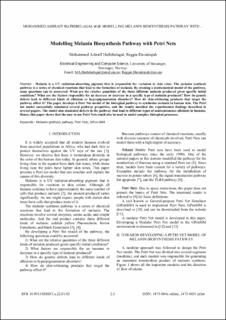| dc.contributor.author | Hathibelaga, Mohammed Ashraff | |
| dc.contributor.author | Davidrajuh, Reggie | |
| dc.date.accessioned | 2023-02-09T08:52:14Z | |
| dc.date.available | 2023-02-09T08:52:14Z | |
| dc.date.created | 2022-01-27T07:37:06Z | |
| dc.date.issued | 2021 | |
| dc.identifier.citation | Hathibelagal, M. A., & Davidrajuh, R. (2021). Modelling Melanin Biosynthesis Pathway with Petri Nets. International Journal of Simulation--Systems, Science & Technology, 22(1). | en_US |
| dc.identifier.issn | 1473-8031 | |
| dc.identifier.uri | https://hdl.handle.net/11250/3049521 | |
| dc.description.abstract | Melanin is a UV radiation-absorbing pigment that is responsible for variation in skin color. The melanin synthesis pathway is a series of chemical reactions that lead to the formation of melanin. By creating a mathematical model of the pathway, some questions can be answered: What are the relative quantities of the three different melanin produced given specific initial conditions? What are the factors responsible for an increase or decrease in a specific type of melanin produced? How do genetic defects lead to different kinds of albinism or hyperpigmentation disorders? How do skin-whitening products that target the pathway affect it? The paper develops a Petri Net model of the biological pathway to synthesise melanin in human skin. The Petri net model successfully simulated several pathway properties, and the results matched the experimental findings described in several papers. The model also simulated defects in the pathway that lead to different types of oculocutaneous albinism in humans. Hence, this paper shows that the easy to use Petri Nets could also be used to model complex biological processes. | en_US |
| dc.language.iso | eng | en_US |
| dc.publisher | United Kingdom Simulation Society | en_US |
| dc.title | Modelling Melanin Biosynthesis Pathway with Petri Nets | en_US |
| dc.type | Peer reviewed | en_US |
| dc.type | Journal article | en_US |
| dc.description.version | publishedVersion | en_US |
| dc.rights.holder | The owners/authors | en_US |
| dc.subject.nsi | VDP::Teknologi: 500 | en_US |
| dc.source.volume | 22 | en_US |
| dc.source.journal | International Journal of Simulation. Systems, Science and Technology | en_US |
| dc.source.issue | 1 | en_US |
| dc.identifier.doi | 10.5013/IJSSST.a.22.01.02 | |
| dc.identifier.cristin | 1990899 | |
| cristin.ispublished | true | |
| cristin.fulltext | original | |
| cristin.qualitycode | 1 | |
